Engineering Project: Earthquake Vibration Control with Shear Walls
VerifiedAdded on 2020/03/23
|19
|4080
|230
Report
AI Summary
This report examines earthquake vibration control using modified frame shear walls to enhance building safety. It begins with an introduction to the problem and a literature review covering earthquakes, shear walls, and their evaluation. The report delves into seismic evaluation, structural features, and building performance during earthquakes, including the role of reinforced concrete. It explores studies on the use of epoxy grouted dowels for seismic strengthening and discusses the importance of lateral stiffness and ductility. The report also covers the design and construction of shear walls, including reinforcement requirements and boundary elements. It highlights the application of modified frame shear walls in improving building performance during earthquakes. The conclusion summarizes the key findings and emphasizes the importance of understanding earthquake behavior and implementing effective construction methods for earthquake-resistant buildings. The report aims to provide insights into the technology and techniques used to strengthen infrastructures and protect lives, contributing to the reduction of monetary losses caused by earthquakes.
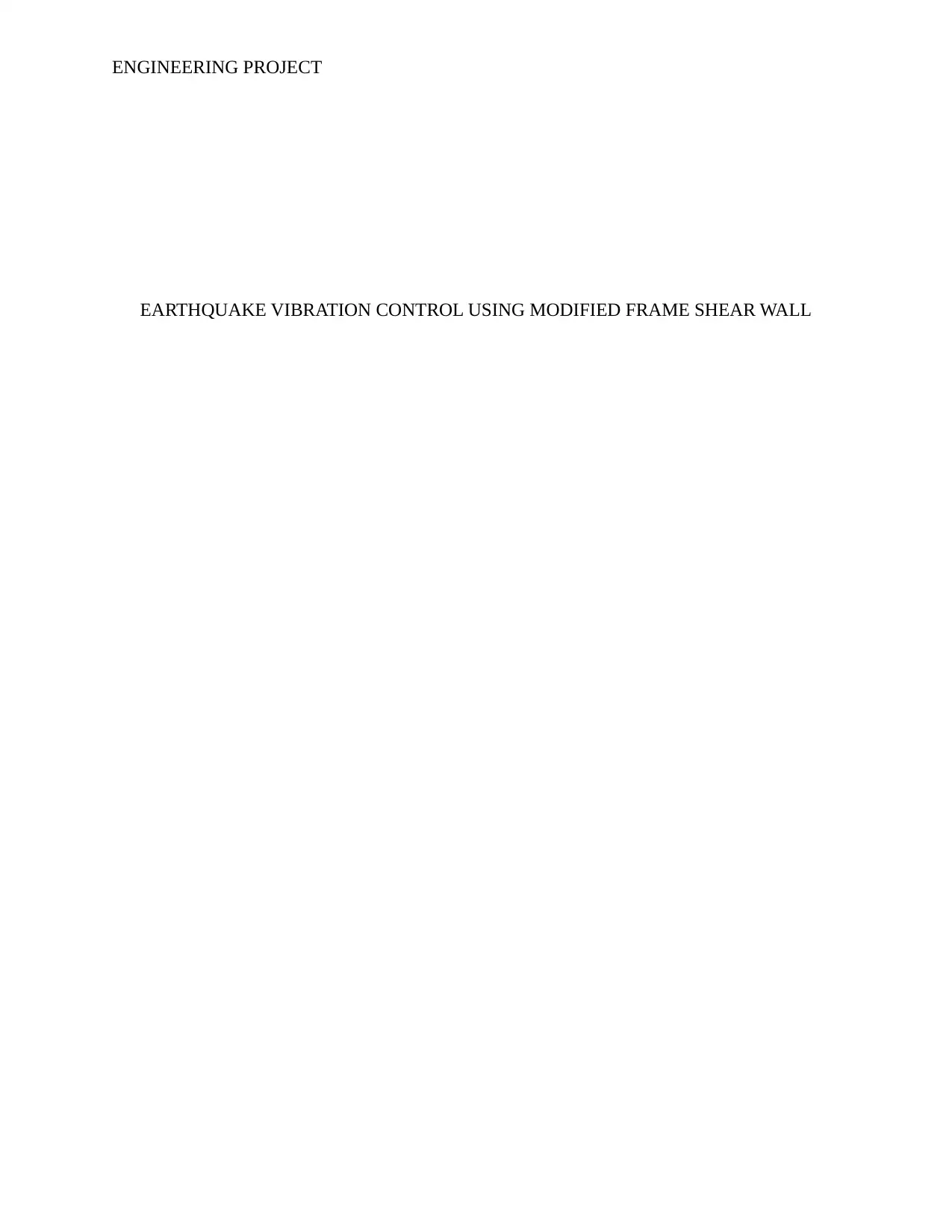
ENGINEERING PROJECT
EARTHQUAKE VIBRATION CONTROL USING MODIFIED FRAME SHEAR WALL
EARTHQUAKE VIBRATION CONTROL USING MODIFIED FRAME SHEAR WALL
Paraphrase This Document
Need a fresh take? Get an instant paraphrase of this document with our AI Paraphraser
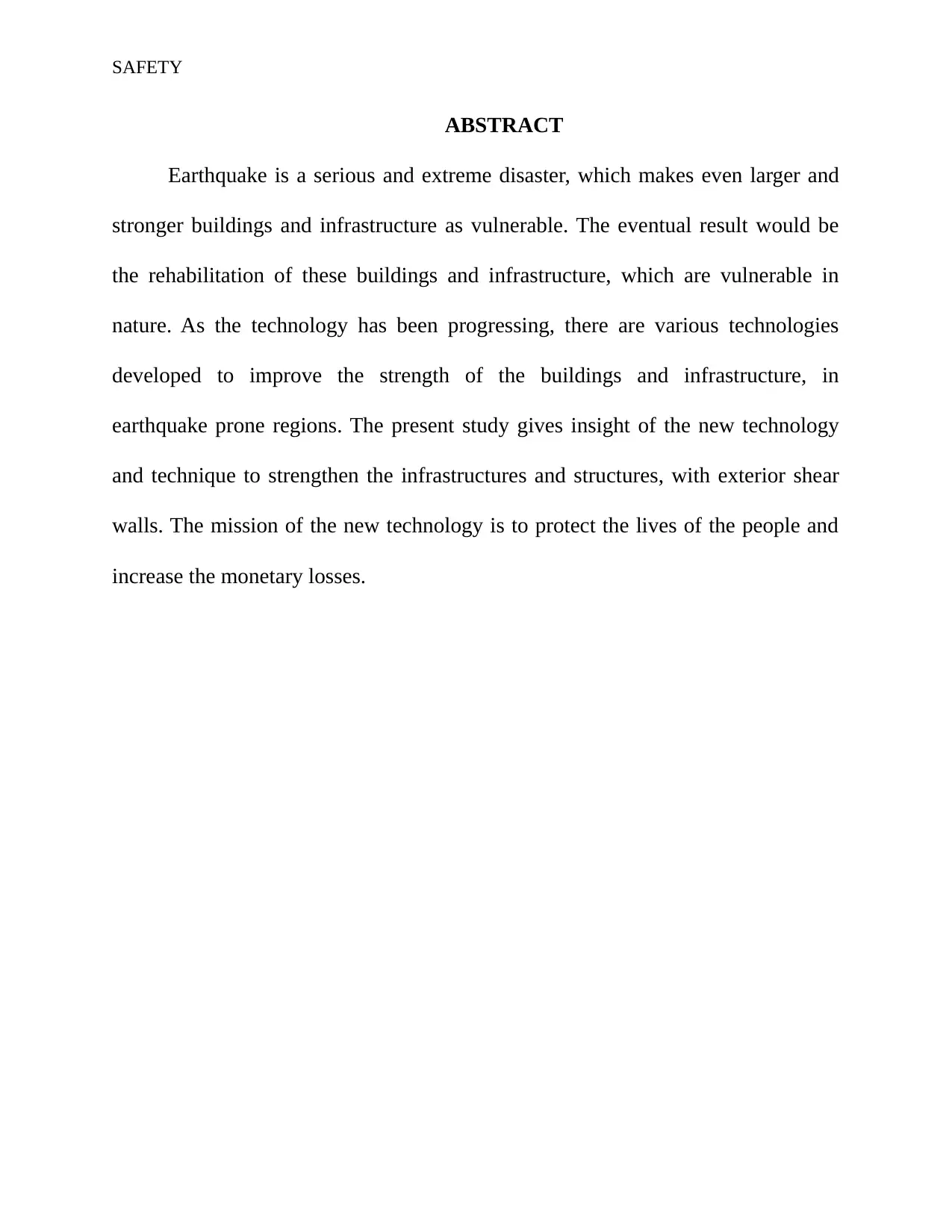
SAFETY
ABSTRACT
Earthquake is a serious and extreme disaster, which makes even larger and
stronger buildings and infrastructure as vulnerable. The eventual result would be
the rehabilitation of these buildings and infrastructure, which are vulnerable in
nature. As the technology has been progressing, there are various technologies
developed to improve the strength of the buildings and infrastructure, in
earthquake prone regions. The present study gives insight of the new technology
and technique to strengthen the infrastructures and structures, with exterior shear
walls. The mission of the new technology is to protect the lives of the people and
increase the monetary losses.
ABSTRACT
Earthquake is a serious and extreme disaster, which makes even larger and
stronger buildings and infrastructure as vulnerable. The eventual result would be
the rehabilitation of these buildings and infrastructure, which are vulnerable in
nature. As the technology has been progressing, there are various technologies
developed to improve the strength of the buildings and infrastructure, in
earthquake prone regions. The present study gives insight of the new technology
and technique to strengthen the infrastructures and structures, with exterior shear
walls. The mission of the new technology is to protect the lives of the people and
increase the monetary losses.
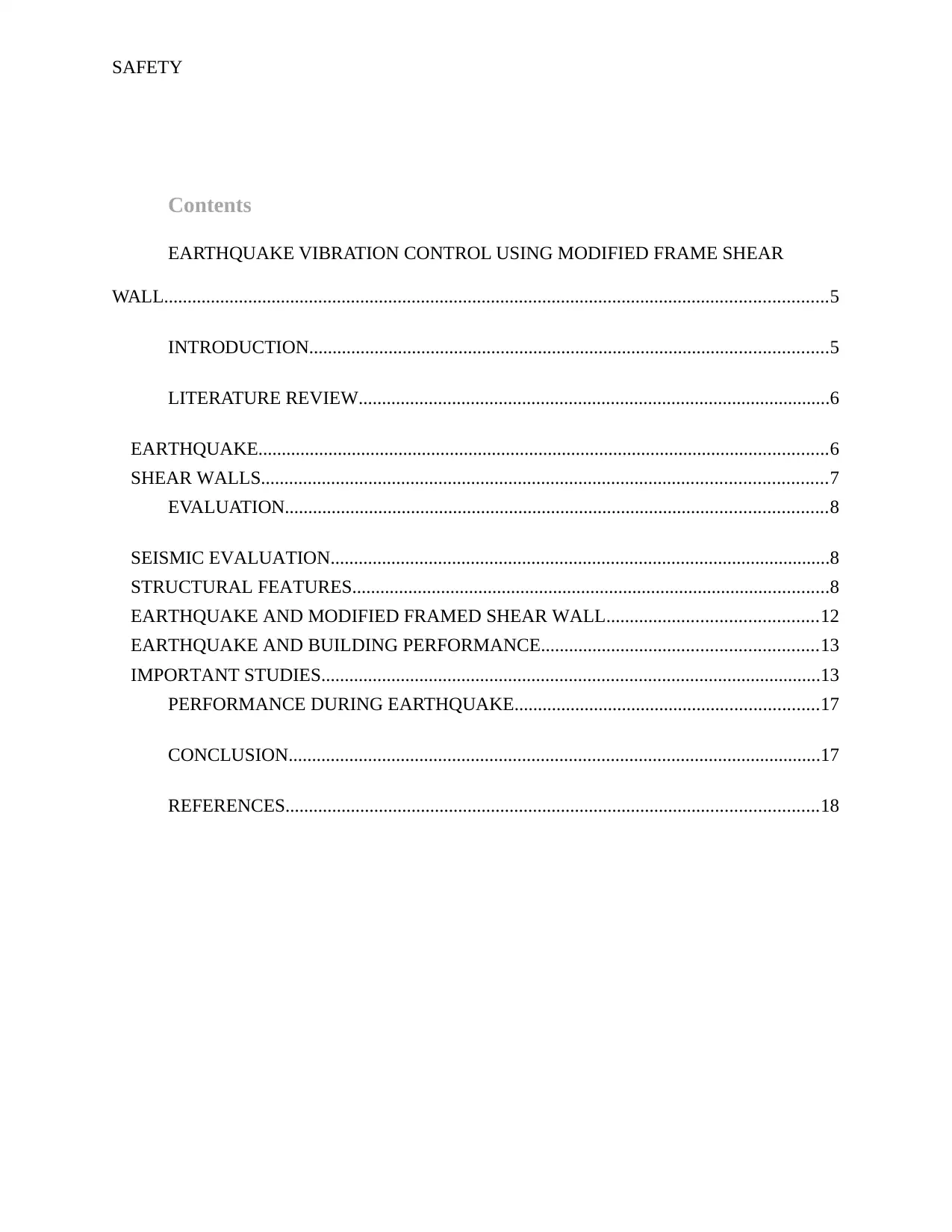
SAFETY
Contents
EARTHQUAKE VIBRATION CONTROL USING MODIFIED FRAME SHEAR
WALL..............................................................................................................................................5
INTRODUCTION...............................................................................................................5
LITERATURE REVIEW.....................................................................................................6
EARTHQUAKE..........................................................................................................................6
SHEAR WALLS.........................................................................................................................7
EVALUATION....................................................................................................................8
SEISMIC EVALUATION...........................................................................................................8
STRUCTURAL FEATURES......................................................................................................8
EARTHQUAKE AND MODIFIED FRAMED SHEAR WALL.............................................12
EARTHQUAKE AND BUILDING PERFORMANCE...........................................................13
IMPORTANT STUDIES...........................................................................................................13
PERFORMANCE DURING EARTHQUAKE.................................................................17
CONCLUSION..................................................................................................................17
REFERENCES..................................................................................................................18
Contents
EARTHQUAKE VIBRATION CONTROL USING MODIFIED FRAME SHEAR
WALL..............................................................................................................................................5
INTRODUCTION...............................................................................................................5
LITERATURE REVIEW.....................................................................................................6
EARTHQUAKE..........................................................................................................................6
SHEAR WALLS.........................................................................................................................7
EVALUATION....................................................................................................................8
SEISMIC EVALUATION...........................................................................................................8
STRUCTURAL FEATURES......................................................................................................8
EARTHQUAKE AND MODIFIED FRAMED SHEAR WALL.............................................12
EARTHQUAKE AND BUILDING PERFORMANCE...........................................................13
IMPORTANT STUDIES...........................................................................................................13
PERFORMANCE DURING EARTHQUAKE.................................................................17
CONCLUSION..................................................................................................................17
REFERENCES..................................................................................................................18
⊘ This is a preview!⊘
Do you want full access?
Subscribe today to unlock all pages.

Trusted by 1+ million students worldwide
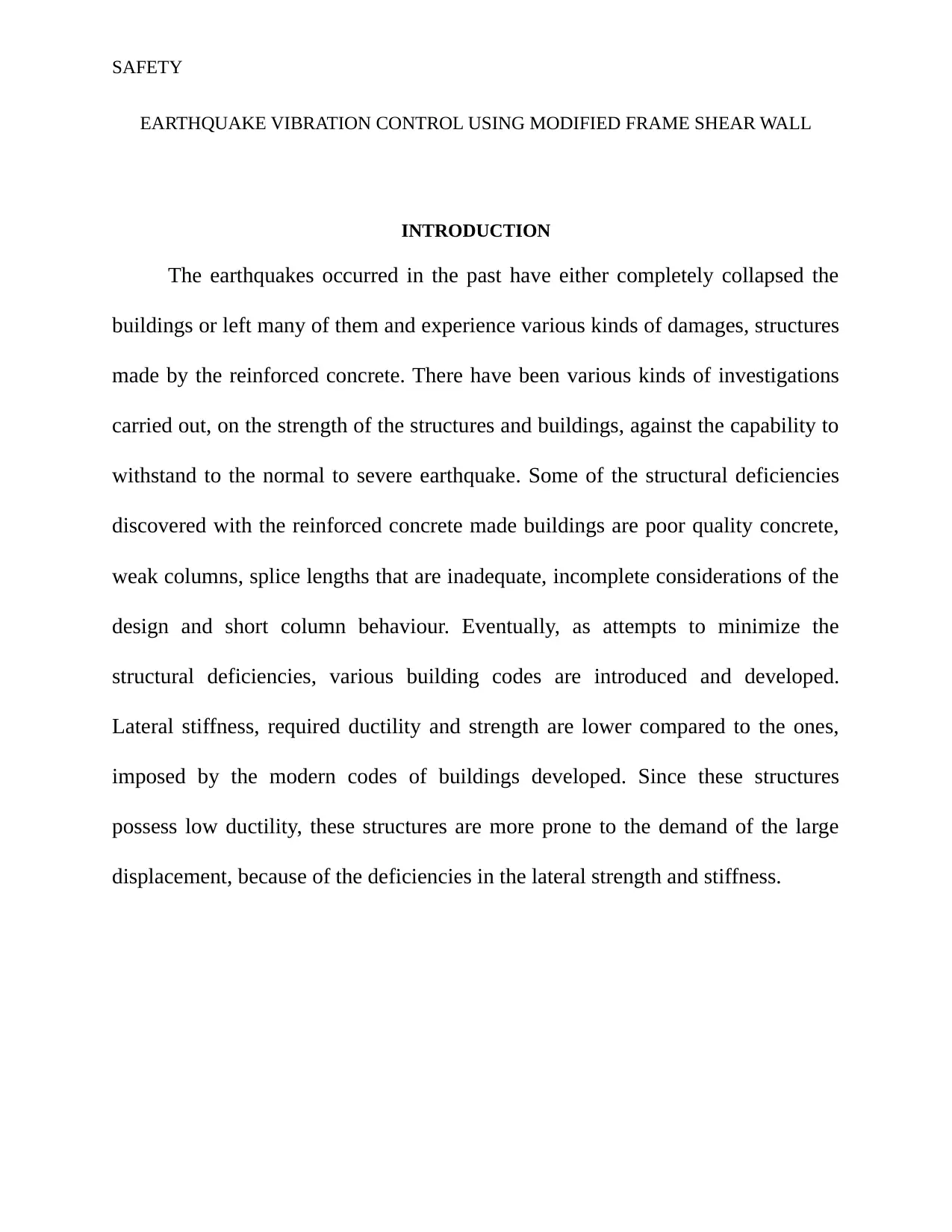
SAFETY
EARTHQUAKE VIBRATION CONTROL USING MODIFIED FRAME SHEAR WALL
INTRODUCTION
The earthquakes occurred in the past have either completely collapsed the
buildings or left many of them and experience various kinds of damages, structures
made by the reinforced concrete. There have been various kinds of investigations
carried out, on the strength of the structures and buildings, against the capability to
withstand to the normal to severe earthquake. Some of the structural deficiencies
discovered with the reinforced concrete made buildings are poor quality concrete,
weak columns, splice lengths that are inadequate, incomplete considerations of the
design and short column behaviour. Eventually, as attempts to minimize the
structural deficiencies, various building codes are introduced and developed.
Lateral stiffness, required ductility and strength are lower compared to the ones,
imposed by the modern codes of buildings developed. Since these structures
possess low ductility, these structures are more prone to the demand of the large
displacement, because of the deficiencies in the lateral strength and stiffness.
EARTHQUAKE VIBRATION CONTROL USING MODIFIED FRAME SHEAR WALL
INTRODUCTION
The earthquakes occurred in the past have either completely collapsed the
buildings or left many of them and experience various kinds of damages, structures
made by the reinforced concrete. There have been various kinds of investigations
carried out, on the strength of the structures and buildings, against the capability to
withstand to the normal to severe earthquake. Some of the structural deficiencies
discovered with the reinforced concrete made buildings are poor quality concrete,
weak columns, splice lengths that are inadequate, incomplete considerations of the
design and short column behaviour. Eventually, as attempts to minimize the
structural deficiencies, various building codes are introduced and developed.
Lateral stiffness, required ductility and strength are lower compared to the ones,
imposed by the modern codes of buildings developed. Since these structures
possess low ductility, these structures are more prone to the demand of the large
displacement, because of the deficiencies in the lateral strength and stiffness.
Paraphrase This Document
Need a fresh take? Get an instant paraphrase of this document with our AI Paraphraser
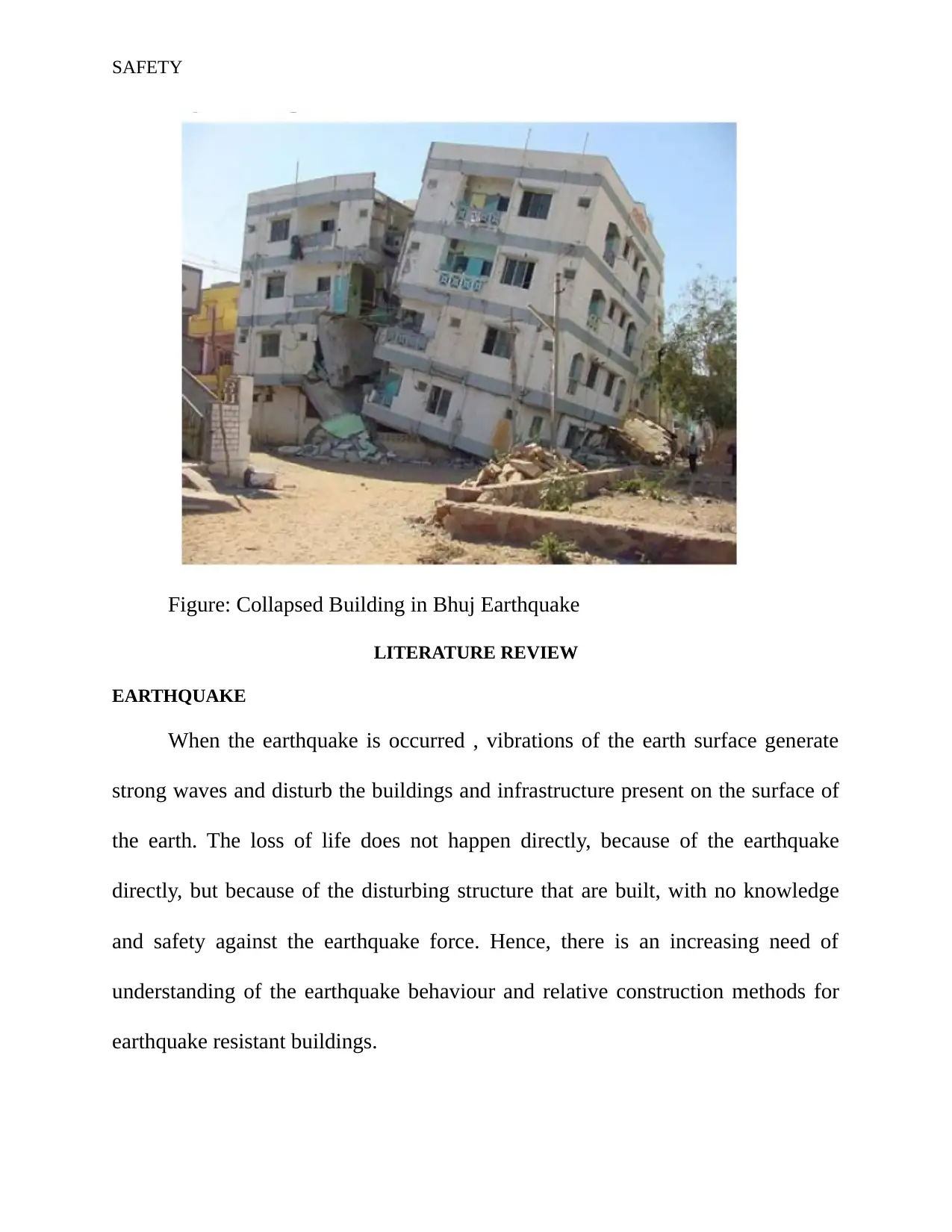
SAFETY
Figure: Collapsed Building in Bhuj Earthquake
LITERATURE REVIEW
EARTHQUAKE
When the earthquake is occurred , vibrations of the earth surface generate
strong waves and disturb the buildings and infrastructure present on the surface of
the earth. The loss of life does not happen directly, because of the earthquake
directly, but because of the disturbing structure that are built, with no knowledge
and safety against the earthquake force. Hence, there is an increasing need of
understanding of the earthquake behaviour and relative construction methods for
earthquake resistant buildings.
Figure: Collapsed Building in Bhuj Earthquake
LITERATURE REVIEW
EARTHQUAKE
When the earthquake is occurred , vibrations of the earth surface generate
strong waves and disturb the buildings and infrastructure present on the surface of
the earth. The loss of life does not happen directly, because of the earthquake
directly, but because of the disturbing structure that are built, with no knowledge
and safety against the earthquake force. Hence, there is an increasing need of
understanding of the earthquake behaviour and relative construction methods for
earthquake resistant buildings.
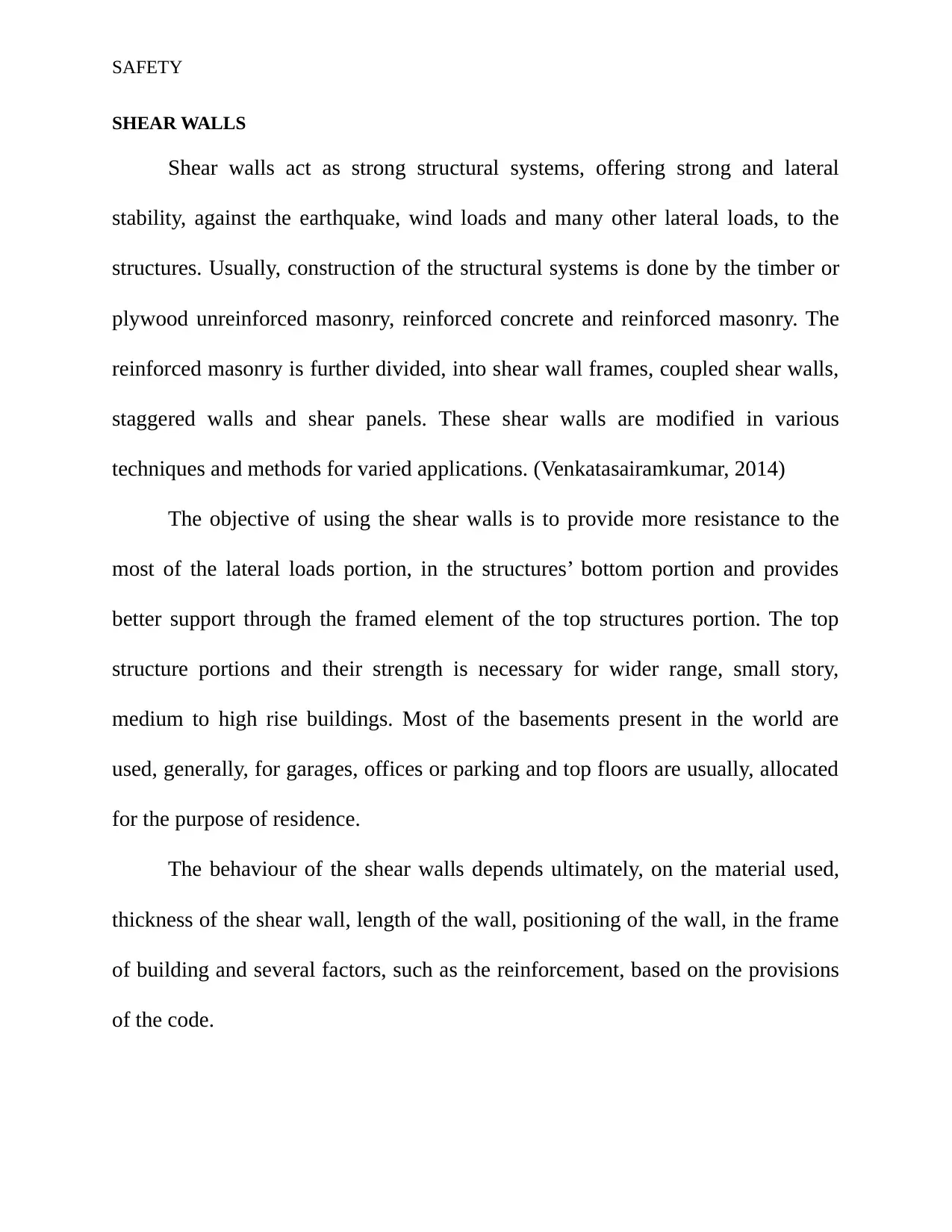
SAFETY
SHEAR WALLS
Shear walls act as strong structural systems, offering strong and lateral
stability, against the earthquake, wind loads and many other lateral loads, to the
structures. Usually, construction of the structural systems is done by the timber or
plywood unreinforced masonry, reinforced concrete and reinforced masonry. The
reinforced masonry is further divided, into shear wall frames, coupled shear walls,
staggered walls and shear panels. These shear walls are modified in various
techniques and methods for varied applications. (Venkatasairamkumar, 2014)
The objective of using the shear walls is to provide more resistance to the
most of the lateral loads portion, in the structures’ bottom portion and provides
better support through the framed element of the top structures portion. The top
structure portions and their strength is necessary for wider range, small story,
medium to high rise buildings. Most of the basements present in the world are
used, generally, for garages, offices or parking and top floors are usually, allocated
for the purpose of residence.
The behaviour of the shear walls depends ultimately, on the material used,
thickness of the shear wall, length of the wall, positioning of the wall, in the frame
of building and several factors, such as the reinforcement, based on the provisions
of the code.
SHEAR WALLS
Shear walls act as strong structural systems, offering strong and lateral
stability, against the earthquake, wind loads and many other lateral loads, to the
structures. Usually, construction of the structural systems is done by the timber or
plywood unreinforced masonry, reinforced concrete and reinforced masonry. The
reinforced masonry is further divided, into shear wall frames, coupled shear walls,
staggered walls and shear panels. These shear walls are modified in various
techniques and methods for varied applications. (Venkatasairamkumar, 2014)
The objective of using the shear walls is to provide more resistance to the
most of the lateral loads portion, in the structures’ bottom portion and provides
better support through the framed element of the top structures portion. The top
structure portions and their strength is necessary for wider range, small story,
medium to high rise buildings. Most of the basements present in the world are
used, generally, for garages, offices or parking and top floors are usually, allocated
for the purpose of residence.
The behaviour of the shear walls depends ultimately, on the material used,
thickness of the shear wall, length of the wall, positioning of the wall, in the frame
of building and several factors, such as the reinforcement, based on the provisions
of the code.
⊘ This is a preview!⊘
Do you want full access?
Subscribe today to unlock all pages.

Trusted by 1+ million students worldwide
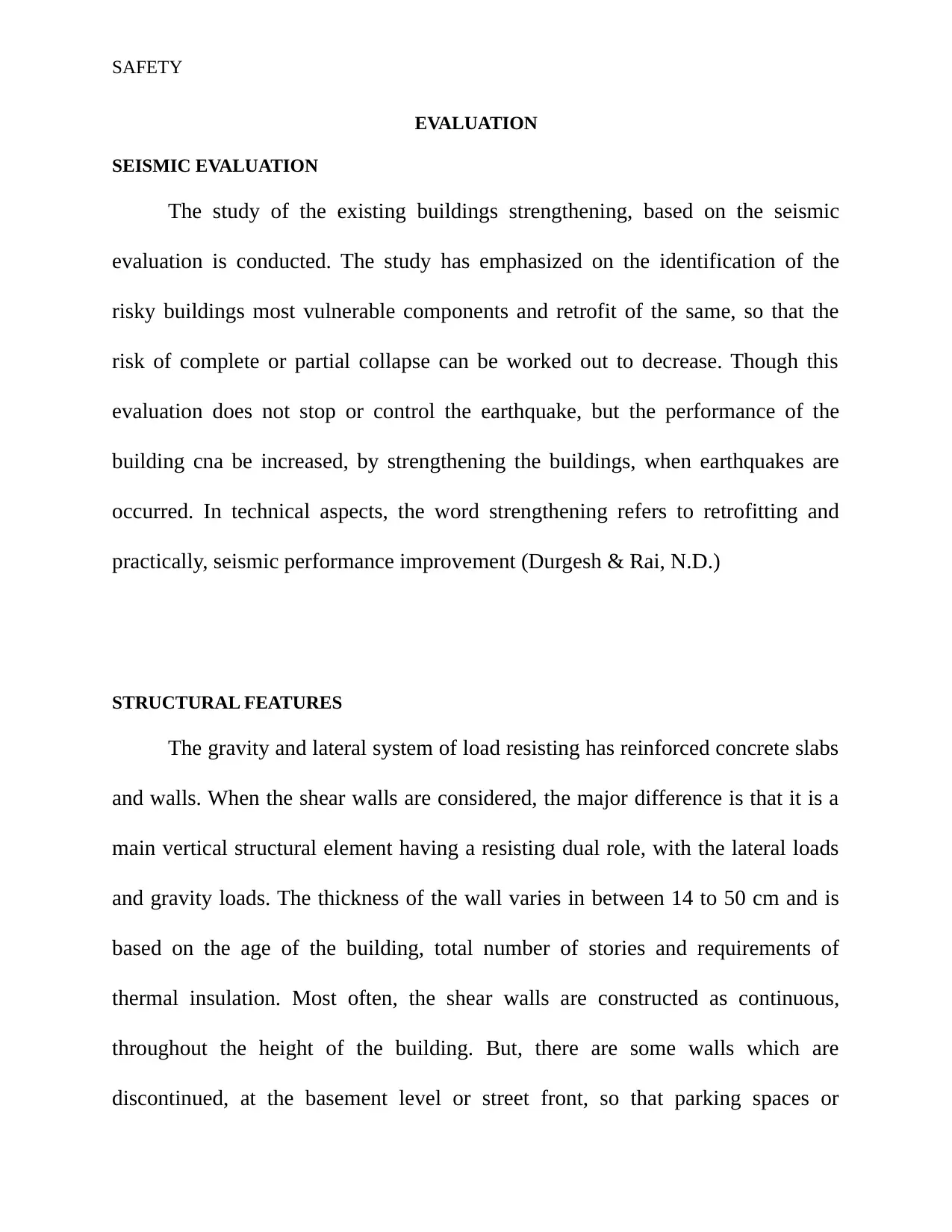
SAFETY
EVALUATION
SEISMIC EVALUATION
The study of the existing buildings strengthening, based on the seismic
evaluation is conducted. The study has emphasized on the identification of the
risky buildings most vulnerable components and retrofit of the same, so that the
risk of complete or partial collapse can be worked out to decrease. Though this
evaluation does not stop or control the earthquake, but the performance of the
building cna be increased, by strengthening the buildings, when earthquakes are
occurred. In technical aspects, the word strengthening refers to retrofitting and
practically, seismic performance improvement (Durgesh & Rai, N.D.)
STRUCTURAL FEATURES
The gravity and lateral system of load resisting has reinforced concrete slabs
and walls. When the shear walls are considered, the major difference is that it is a
main vertical structural element having a resisting dual role, with the lateral loads
and gravity loads. The thickness of the wall varies in between 14 to 50 cm and is
based on the age of the building, total number of stories and requirements of
thermal insulation. Most often, the shear walls are constructed as continuous,
throughout the height of the building. But, there are some walls which are
discontinued, at the basement level or street front, so that parking spaces or
EVALUATION
SEISMIC EVALUATION
The study of the existing buildings strengthening, based on the seismic
evaluation is conducted. The study has emphasized on the identification of the
risky buildings most vulnerable components and retrofit of the same, so that the
risk of complete or partial collapse can be worked out to decrease. Though this
evaluation does not stop or control the earthquake, but the performance of the
building cna be increased, by strengthening the buildings, when earthquakes are
occurred. In technical aspects, the word strengthening refers to retrofitting and
practically, seismic performance improvement (Durgesh & Rai, N.D.)
STRUCTURAL FEATURES
The gravity and lateral system of load resisting has reinforced concrete slabs
and walls. When the shear walls are considered, the major difference is that it is a
main vertical structural element having a resisting dual role, with the lateral loads
and gravity loads. The thickness of the wall varies in between 14 to 50 cm and is
based on the age of the building, total number of stories and requirements of
thermal insulation. Most often, the shear walls are constructed as continuous,
throughout the height of the building. But, there are some walls which are
discontinued, at the basement level or street front, so that parking spaces or
Paraphrase This Document
Need a fresh take? Get an instant paraphrase of this document with our AI Paraphraser
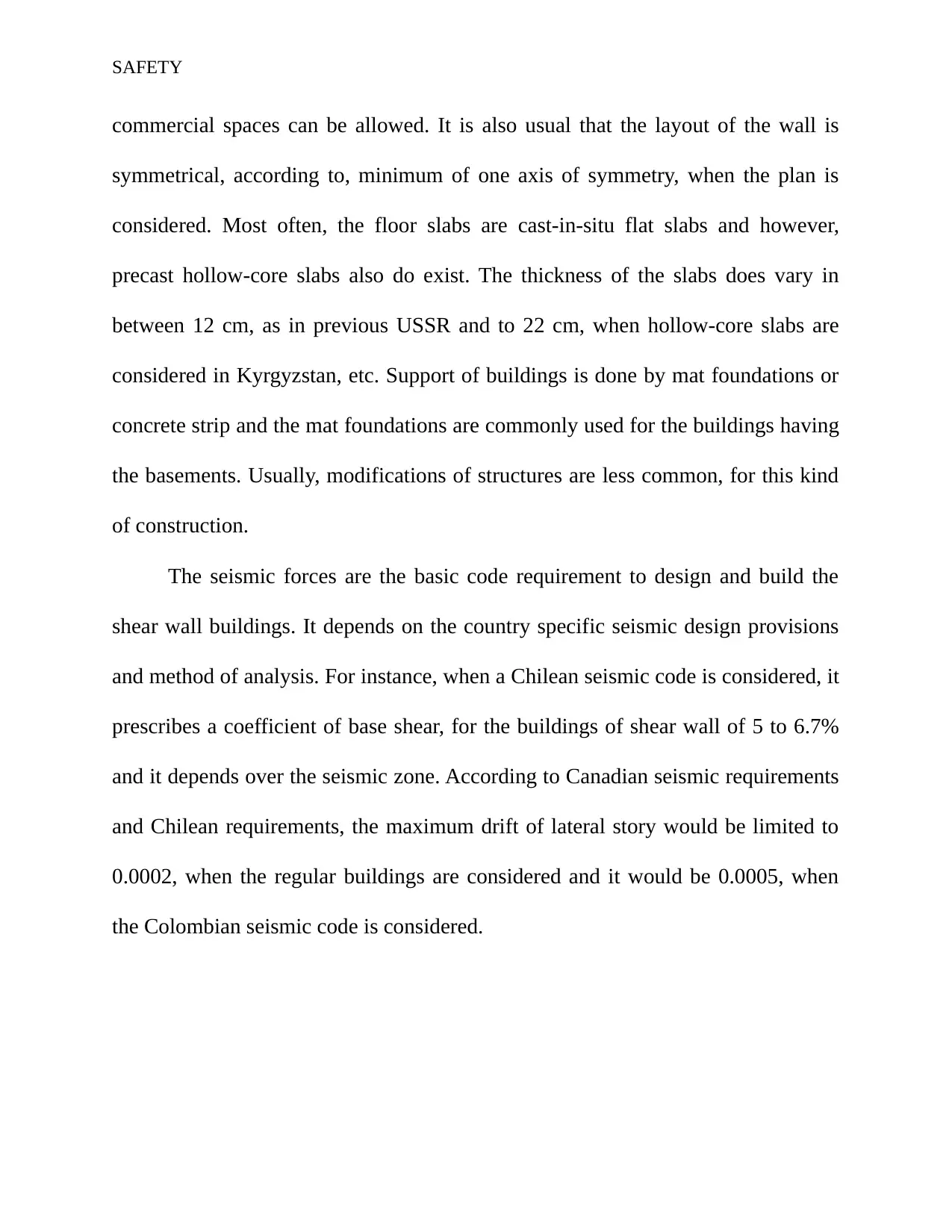
SAFETY
commercial spaces can be allowed. It is also usual that the layout of the wall is
symmetrical, according to, minimum of one axis of symmetry, when the plan is
considered. Most often, the floor slabs are cast-in-situ flat slabs and however,
precast hollow-core slabs also do exist. The thickness of the slabs does vary in
between 12 cm, as in previous USSR and to 22 cm, when hollow-core slabs are
considered in Kyrgyzstan, etc. Support of buildings is done by mat foundations or
concrete strip and the mat foundations are commonly used for the buildings having
the basements. Usually, modifications of structures are less common, for this kind
of construction.
The seismic forces are the basic code requirement to design and build the
shear wall buildings. It depends on the country specific seismic design provisions
and method of analysis. For instance, when a Chilean seismic code is considered, it
prescribes a coefficient of base shear, for the buildings of shear wall of 5 to 6.7%
and it depends over the seismic zone. According to Canadian seismic requirements
and Chilean requirements, the maximum drift of lateral story would be limited to
0.0002, when the regular buildings are considered and it would be 0.0005, when
the Colombian seismic code is considered.
commercial spaces can be allowed. It is also usual that the layout of the wall is
symmetrical, according to, minimum of one axis of symmetry, when the plan is
considered. Most often, the floor slabs are cast-in-situ flat slabs and however,
precast hollow-core slabs also do exist. The thickness of the slabs does vary in
between 12 cm, as in previous USSR and to 22 cm, when hollow-core slabs are
considered in Kyrgyzstan, etc. Support of buildings is done by mat foundations or
concrete strip and the mat foundations are commonly used for the buildings having
the basements. Usually, modifications of structures are less common, for this kind
of construction.
The seismic forces are the basic code requirement to design and build the
shear wall buildings. It depends on the country specific seismic design provisions
and method of analysis. For instance, when a Chilean seismic code is considered, it
prescribes a coefficient of base shear, for the buildings of shear wall of 5 to 6.7%
and it depends over the seismic zone. According to Canadian seismic requirements
and Chilean requirements, the maximum drift of lateral story would be limited to
0.0002, when the regular buildings are considered and it would be 0.0005, when
the Colombian seismic code is considered.
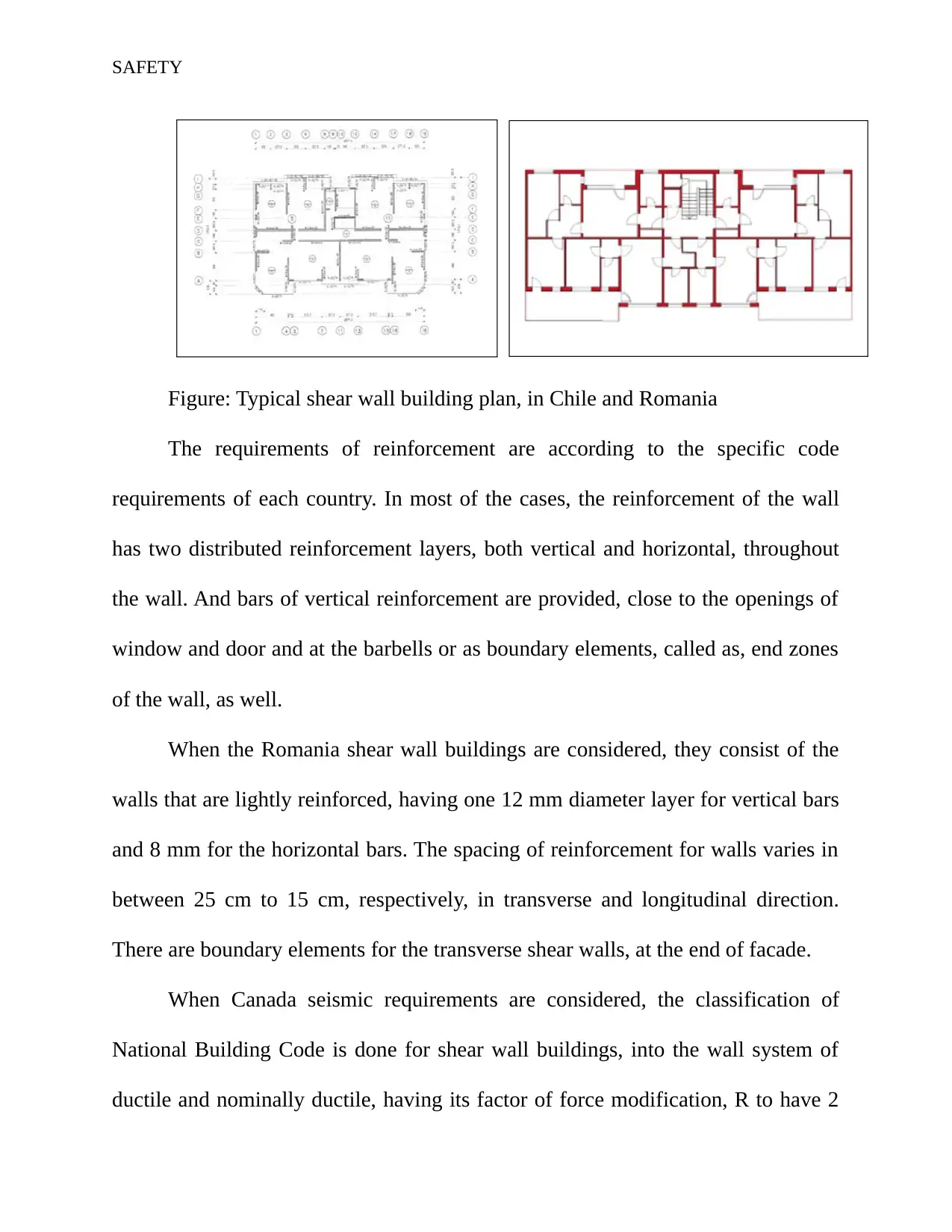
SAFETY
Figure: Typical shear wall building plan, in Chile and Romania
The requirements of reinforcement are according to the specific code
requirements of each country. In most of the cases, the reinforcement of the wall
has two distributed reinforcement layers, both vertical and horizontal, throughout
the wall. And bars of vertical reinforcement are provided, close to the openings of
window and door and at the barbells or as boundary elements, called as, end zones
of the wall, as well.
When the Romania shear wall buildings are considered, they consist of the
walls that are lightly reinforced, having one 12 mm diameter layer for vertical bars
and 8 mm for the horizontal bars. The spacing of reinforcement for walls varies in
between 25 cm to 15 cm, respectively, in transverse and longitudinal direction.
There are boundary elements for the transverse shear walls, at the end of facade.
When Canada seismic requirements are considered, the classification of
National Building Code is done for shear wall buildings, into the wall system of
ductile and nominally ductile, having its factor of force modification, R to have 2
Figure: Typical shear wall building plan, in Chile and Romania
The requirements of reinforcement are according to the specific code
requirements of each country. In most of the cases, the reinforcement of the wall
has two distributed reinforcement layers, both vertical and horizontal, throughout
the wall. And bars of vertical reinforcement are provided, close to the openings of
window and door and at the barbells or as boundary elements, called as, end zones
of the wall, as well.
When the Romania shear wall buildings are considered, they consist of the
walls that are lightly reinforced, having one 12 mm diameter layer for vertical bars
and 8 mm for the horizontal bars. The spacing of reinforcement for walls varies in
between 25 cm to 15 cm, respectively, in transverse and longitudinal direction.
There are boundary elements for the transverse shear walls, at the end of facade.
When Canada seismic requirements are considered, the classification of
National Building Code is done for shear wall buildings, into the wall system of
ductile and nominally ductile, having its factor of force modification, R to have 2
⊘ This is a preview!⊘
Do you want full access?
Subscribe today to unlock all pages.

Trusted by 1+ million students worldwide
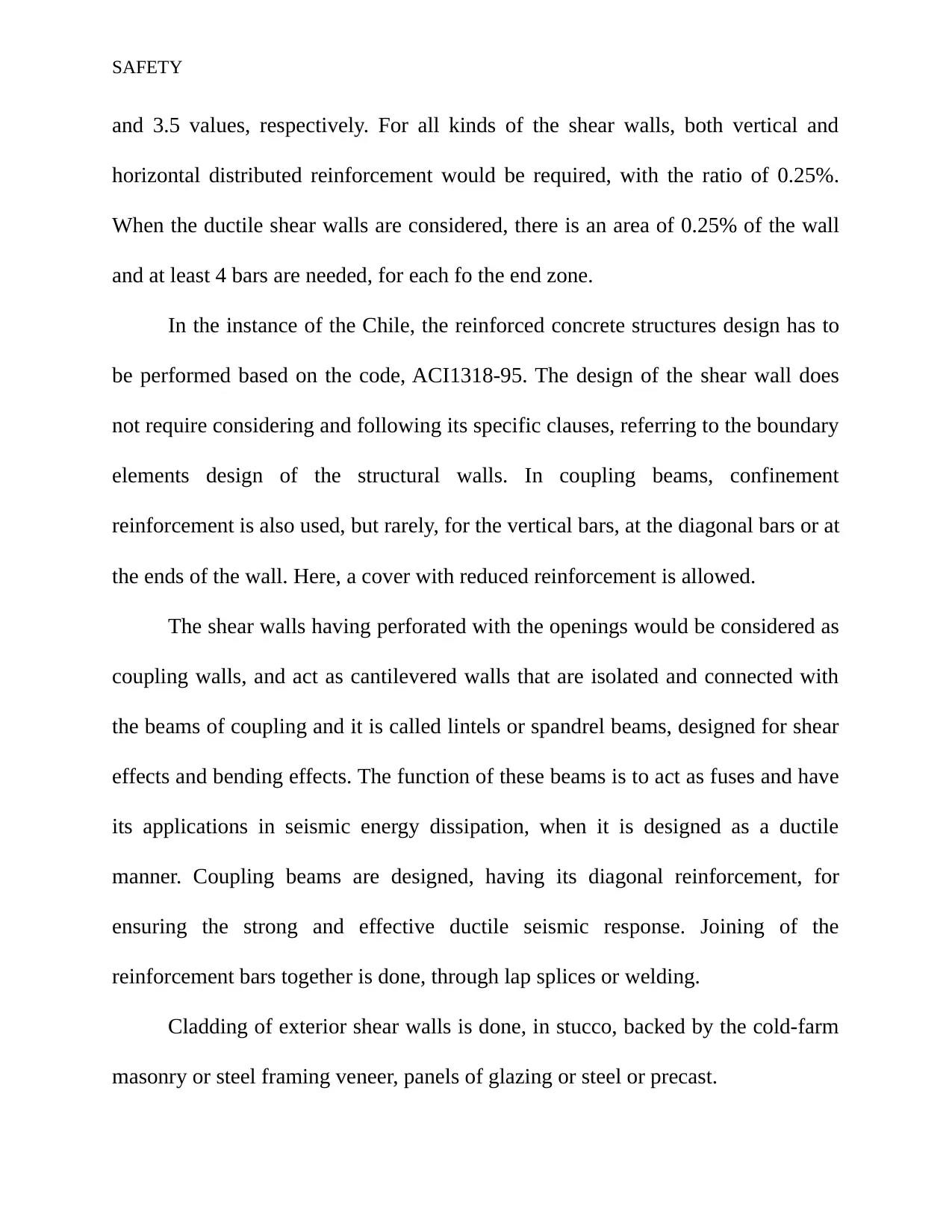
SAFETY
and 3.5 values, respectively. For all kinds of the shear walls, both vertical and
horizontal distributed reinforcement would be required, with the ratio of 0.25%.
When the ductile shear walls are considered, there is an area of 0.25% of the wall
and at least 4 bars are needed, for each fo the end zone.
In the instance of the Chile, the reinforced concrete structures design has to
be performed based on the code, ACI1318-95. The design of the shear wall does
not require considering and following its specific clauses, referring to the boundary
elements design of the structural walls. In coupling beams, confinement
reinforcement is also used, but rarely, for the vertical bars, at the diagonal bars or at
the ends of the wall. Here, a cover with reduced reinforcement is allowed.
The shear walls having perforated with the openings would be considered as
coupling walls, and act as cantilevered walls that are isolated and connected with
the beams of coupling and it is called lintels or spandrel beams, designed for shear
effects and bending effects. The function of these beams is to act as fuses and have
its applications in seismic energy dissipation, when it is designed as a ductile
manner. Coupling beams are designed, having its diagonal reinforcement, for
ensuring the strong and effective ductile seismic response. Joining of the
reinforcement bars together is done, through lap splices or welding.
Cladding of exterior shear walls is done, in stucco, backed by the cold-farm
masonry or steel framing veneer, panels of glazing or steel or precast.
and 3.5 values, respectively. For all kinds of the shear walls, both vertical and
horizontal distributed reinforcement would be required, with the ratio of 0.25%.
When the ductile shear walls are considered, there is an area of 0.25% of the wall
and at least 4 bars are needed, for each fo the end zone.
In the instance of the Chile, the reinforced concrete structures design has to
be performed based on the code, ACI1318-95. The design of the shear wall does
not require considering and following its specific clauses, referring to the boundary
elements design of the structural walls. In coupling beams, confinement
reinforcement is also used, but rarely, for the vertical bars, at the diagonal bars or at
the ends of the wall. Here, a cover with reduced reinforcement is allowed.
The shear walls having perforated with the openings would be considered as
coupling walls, and act as cantilevered walls that are isolated and connected with
the beams of coupling and it is called lintels or spandrel beams, designed for shear
effects and bending effects. The function of these beams is to act as fuses and have
its applications in seismic energy dissipation, when it is designed as a ductile
manner. Coupling beams are designed, having its diagonal reinforcement, for
ensuring the strong and effective ductile seismic response. Joining of the
reinforcement bars together is done, through lap splices or welding.
Cladding of exterior shear walls is done, in stucco, backed by the cold-farm
masonry or steel framing veneer, panels of glazing or steel or precast.
Paraphrase This Document
Need a fresh take? Get an instant paraphrase of this document with our AI Paraphraser
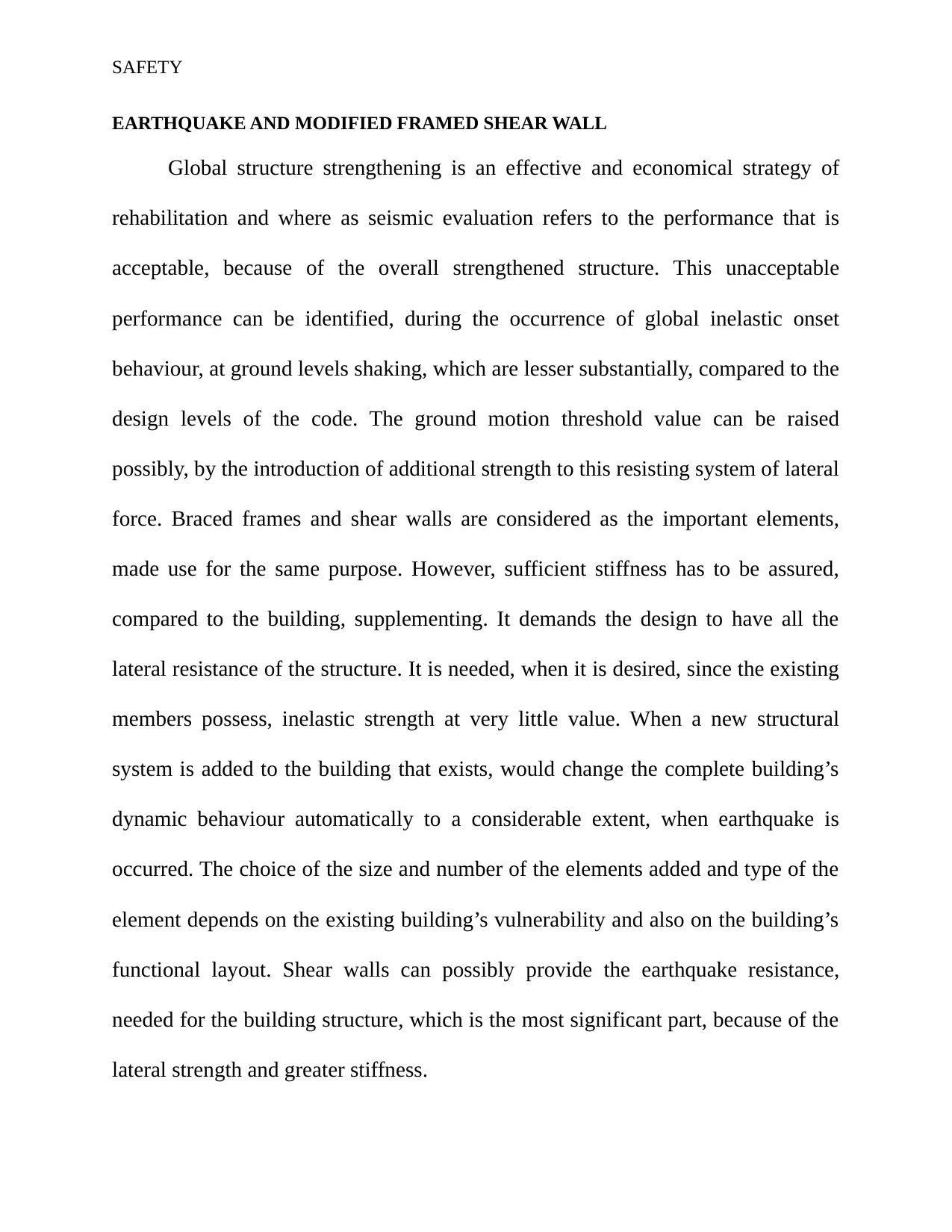
SAFETY
EARTHQUAKE AND MODIFIED FRAMED SHEAR WALL
Global structure strengthening is an effective and economical strategy of
rehabilitation and where as seismic evaluation refers to the performance that is
acceptable, because of the overall strengthened structure. This unacceptable
performance can be identified, during the occurrence of global inelastic onset
behaviour, at ground levels shaking, which are lesser substantially, compared to the
design levels of the code. The ground motion threshold value can be raised
possibly, by the introduction of additional strength to this resisting system of lateral
force. Braced frames and shear walls are considered as the important elements,
made use for the same purpose. However, sufficient stiffness has to be assured,
compared to the building, supplementing. It demands the design to have all the
lateral resistance of the structure. It is needed, when it is desired, since the existing
members possess, inelastic strength at very little value. When a new structural
system is added to the building that exists, would change the complete building’s
dynamic behaviour automatically to a considerable extent, when earthquake is
occurred. The choice of the size and number of the elements added and type of the
element depends on the existing building’s vulnerability and also on the building’s
functional layout. Shear walls can possibly provide the earthquake resistance,
needed for the building structure, which is the most significant part, because of the
lateral strength and greater stiffness.
EARTHQUAKE AND MODIFIED FRAMED SHEAR WALL
Global structure strengthening is an effective and economical strategy of
rehabilitation and where as seismic evaluation refers to the performance that is
acceptable, because of the overall strengthened structure. This unacceptable
performance can be identified, during the occurrence of global inelastic onset
behaviour, at ground levels shaking, which are lesser substantially, compared to the
design levels of the code. The ground motion threshold value can be raised
possibly, by the introduction of additional strength to this resisting system of lateral
force. Braced frames and shear walls are considered as the important elements,
made use for the same purpose. However, sufficient stiffness has to be assured,
compared to the building, supplementing. It demands the design to have all the
lateral resistance of the structure. It is needed, when it is desired, since the existing
members possess, inelastic strength at very little value. When a new structural
system is added to the building that exists, would change the complete building’s
dynamic behaviour automatically to a considerable extent, when earthquake is
occurred. The choice of the size and number of the elements added and type of the
element depends on the existing building’s vulnerability and also on the building’s
functional layout. Shear walls can possibly provide the earthquake resistance,
needed for the building structure, which is the most significant part, because of the
lateral strength and greater stiffness.
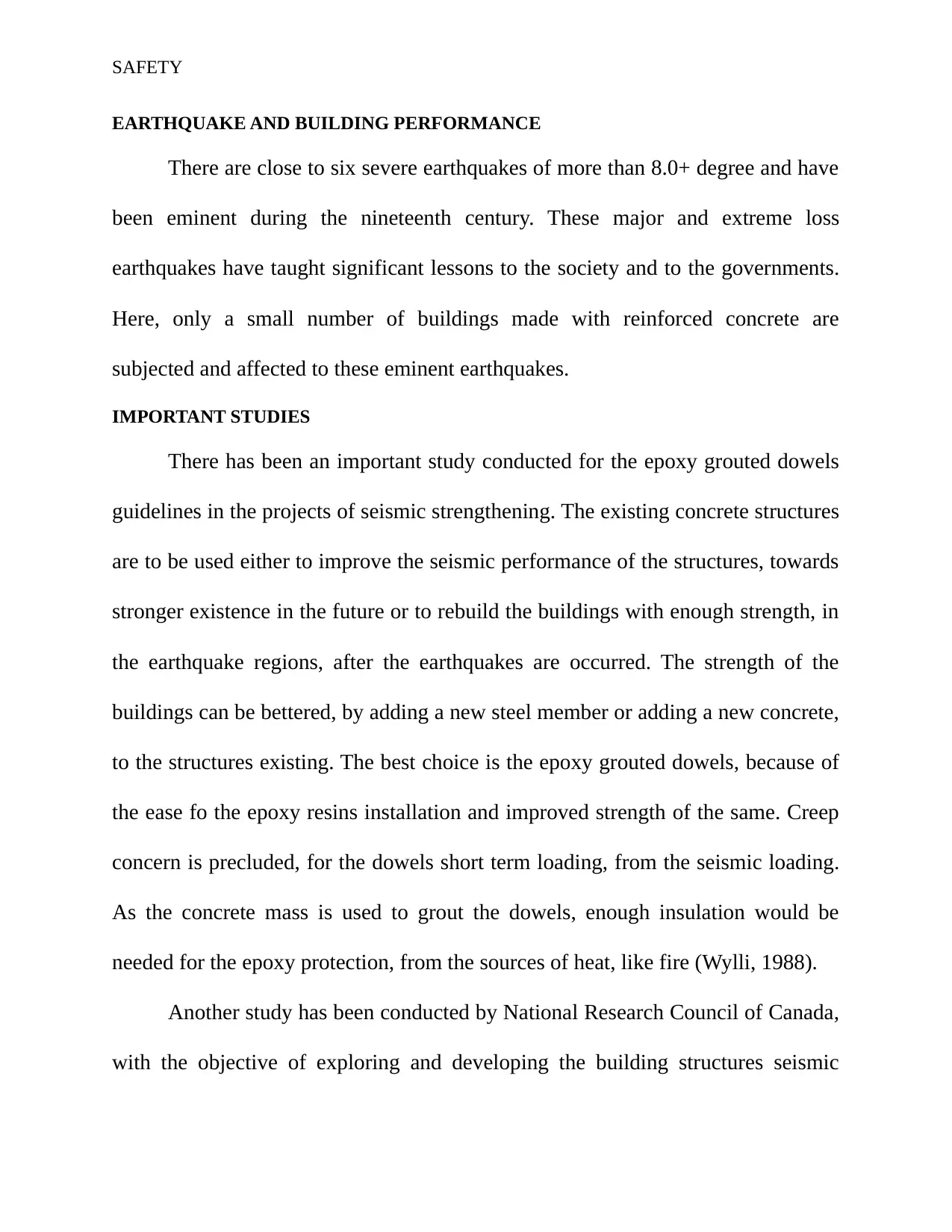
SAFETY
EARTHQUAKE AND BUILDING PERFORMANCE
There are close to six severe earthquakes of more than 8.0+ degree and have
been eminent during the nineteenth century. These major and extreme loss
earthquakes have taught significant lessons to the society and to the governments.
Here, only a small number of buildings made with reinforced concrete are
subjected and affected to these eminent earthquakes.
IMPORTANT STUDIES
There has been an important study conducted for the epoxy grouted dowels
guidelines in the projects of seismic strengthening. The existing concrete structures
are to be used either to improve the seismic performance of the structures, towards
stronger existence in the future or to rebuild the buildings with enough strength, in
the earthquake regions, after the earthquakes are occurred. The strength of the
buildings can be bettered, by adding a new steel member or adding a new concrete,
to the structures existing. The best choice is the epoxy grouted dowels, because of
the ease fo the epoxy resins installation and improved strength of the same. Creep
concern is precluded, for the dowels short term loading, from the seismic loading.
As the concrete mass is used to grout the dowels, enough insulation would be
needed for the epoxy protection, from the sources of heat, like fire (Wylli, 1988).
Another study has been conducted by National Research Council of Canada,
with the objective of exploring and developing the building structures seismic
EARTHQUAKE AND BUILDING PERFORMANCE
There are close to six severe earthquakes of more than 8.0+ degree and have
been eminent during the nineteenth century. These major and extreme loss
earthquakes have taught significant lessons to the society and to the governments.
Here, only a small number of buildings made with reinforced concrete are
subjected and affected to these eminent earthquakes.
IMPORTANT STUDIES
There has been an important study conducted for the epoxy grouted dowels
guidelines in the projects of seismic strengthening. The existing concrete structures
are to be used either to improve the seismic performance of the structures, towards
stronger existence in the future or to rebuild the buildings with enough strength, in
the earthquake regions, after the earthquakes are occurred. The strength of the
buildings can be bettered, by adding a new steel member or adding a new concrete,
to the structures existing. The best choice is the epoxy grouted dowels, because of
the ease fo the epoxy resins installation and improved strength of the same. Creep
concern is precluded, for the dowels short term loading, from the seismic loading.
As the concrete mass is used to grout the dowels, enough insulation would be
needed for the epoxy protection, from the sources of heat, like fire (Wylli, 1988).
Another study has been conducted by National Research Council of Canada,
with the objective of exploring and developing the building structures seismic
⊘ This is a preview!⊘
Do you want full access?
Subscribe today to unlock all pages.

Trusted by 1+ million students worldwide
1 out of 19
Your All-in-One AI-Powered Toolkit for Academic Success.
+13062052269
info@desklib.com
Available 24*7 on WhatsApp / Email
![[object Object]](/_next/static/media/star-bottom.7253800d.svg)
Unlock your academic potential
Copyright © 2020–2025 A2Z Services. All Rights Reserved. Developed and managed by ZUCOL.

